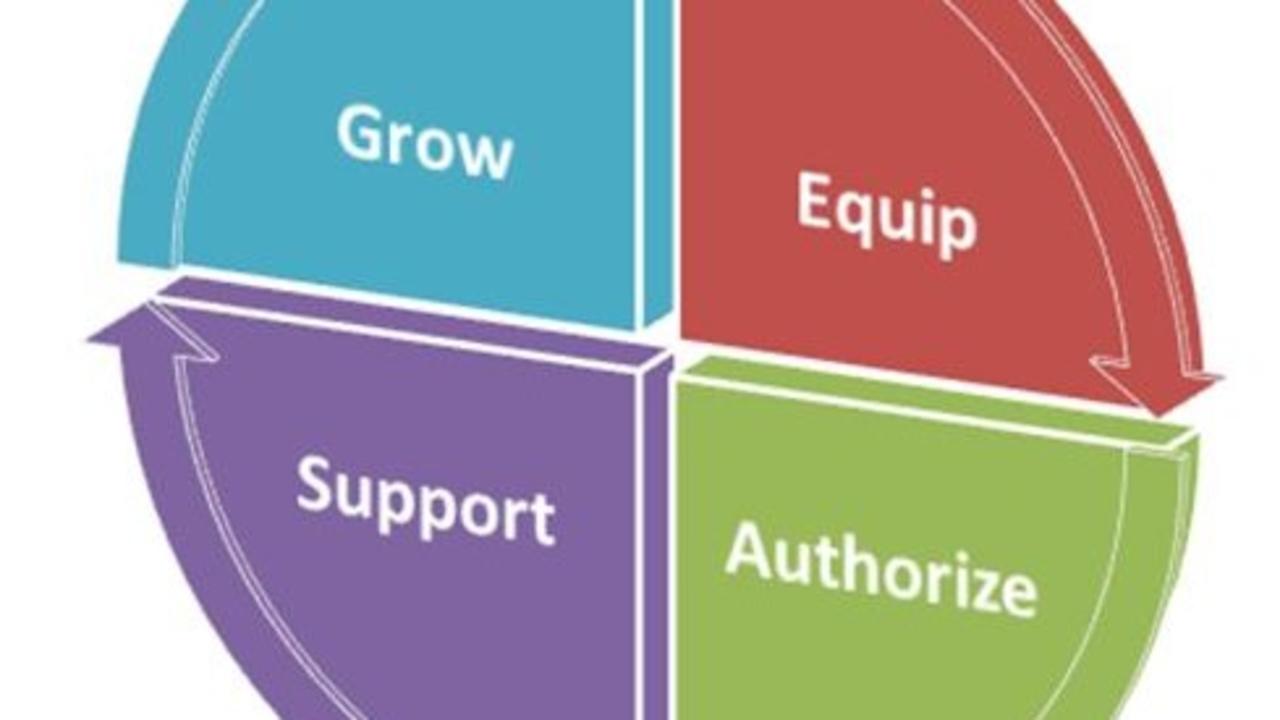The Empowerment Cycle

By Bob Maksimchuk
Empowerment is a word we hear bandied about freely. But what does this mean? Most people struggle to explain it. When asked the more important question of how you empower people, you usually hear a very short, shallow answer such as you just give them a challenging assignment. Either that or you hear crickets.
However you want to define it, it’s more important to understand how you empower people. Empowerment is a process and this process has four mandatory components. If any of these are missing, the result will simply be failure. Here you see the Empowerment Cycle.©

It’s the repetitive, iterating, full cycle process for enabling people to incrementally increase their autonomy so that they can independently and responsibly achieve their goals. Now let me repeat that.
Empowerment is the repetitive, iterative, full cycle process for enabling people to incrementally increase their autonomy so that they can independently and responsibly achieve their goals.
It’s an iterative process because you are not empowering them once for everything they will do for the rest of their life. You are empowering them to handle the immediate task at hand. Start a person’s empowerment with an assignment that’s challenging but commensurate with their abilities. When successful, give them their next more challenging assignment and move through this cycle again, when that’s complete, rinse and repeat.
Let’s take a closer look at each component of the empowerment cycle.
The first step in empowerment is to Equip the person you want to empower. Equip means to give them everything they need to be successful in the task at hand. Clearly, they have to have or must learn the skills they need to be successful in the assignment – both hard and soft skills. But don’t forget, they also need to understand your objectives, your vision, and your values. That is, what do you hold is important and your expectations. If they don’t know what you want, they may execute well but not achieve your desired results.
Next is Authorize. Here’s where many people fall very short. When they supposedly empower people, many think that’s just loading people up with a lot of challenging work and saying, “Have at it”. That’s not empowerment. That’s making people responsible for a heavy workload.
When empowering, you must give that person the responsibility and the authority to get the job done. Without the authority, they can only work within their sphere of influence. Especially in large organizations, your people can easily be ignored by others if they don’t have the authority to decide and act as needed.
Also, you must be clear on the limits of the authority you are lending to them. What are their decision rights, that is, what is within and what is beyond their authority to decide? For example, you may give them the authority to purchase items up to $5,000, but beyond that they have to come back to you for approval. They must also understand any boundaries on their authority. For example, they may be authorized to use 50% of Joe’s time on their assignment, but they can’t hire or fire people. When should they involve certain departments in the work but should not approach others?
And lastly, they must be accountable for the results. Since in the Equip step you made clear your outcomes and expectations, you both must agree on how they will be held accountable for achieving these.
The next step is Support. You must actively demonstrate your support for the person or team you are empowering. Communication must be honest and open, but tempered, that is, not harsh. This person is stretching themselves into new territory. They need to hear that you have faith in them to be successful. They need to be praised along the way on the small successes, you must make it safe for them to stretch and take reasonable risks. If things go wrong, you must correct them gently, providing guidance and not publicly berating them. You need to create a fail-safe situation for them, allowing them to fall short sometimes, but not letting them do things that would be career ending.
And you must be patient. You have to give them time to navigate their way through territory that’s new to them.
Even when the assignment is over, the empowerment is not. They and you must Grow from the prior experience and continue learning deeper and / or develop newer skills to prepare them for the next more challenging opportunity. You must show them the growth path for their careers. It must answer the questions “Why should I risk taking on these challenges? I could just do my job. What’s in it for me?” People need a big enough reason to grow that provides momentum for them to continue to achieve. Obviously, you’re mentoring of them — not micromanaging them or second guessing them — your mentoring of them is crucial throughout this process. And then the empowerment cycle begins again with Equip.
Yes, this is a lot of work and yes, empowerment takes time. But the positive results have been well documented in the industry. Recent studies have shown that employee engagement in their work is at miserably low levels. When people like their work, they’re more engaged, more innovative, and more committed to doing quality work at their jobs. Trust is enhanced between you and your people. Because you trusted them to get the job done without constant supervision, you, they, and the organization all grow to be more capable and high performing.

